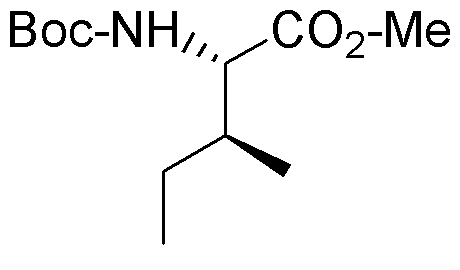Boc-L-isoleucine methyl ester is widely utilized in research focused on:
- Peptide Synthesis: This compound is a key building block in the synthesis of peptides, particularly in solid-phase peptide synthesis, allowing for the creation of complex and biologically active peptides.
- Drug Development: Its role in medicinal chemistry is significant, as it helps in the design of peptide-based drugs, which can lead to more effective treatments with fewer side effects.
- Biotechnology: In the field of biotechnology, it is used to modify proteins, enhancing their stability and activity, which is crucial for various biopharmaceutical applications.
- Research in Protein Engineering: This compound aids researchers in protein engineering by providing a means to introduce specific amino acid sequences, facilitating the study of protein function and interaction.
- Food Industry Applications: Its derivatives can be explored in flavor enhancement and food preservation, contributing to the development of novel food products with improved taste and shelf life.
General Information
Properties
Safety and Regulations
Applications
Boc-L-isoleucine methyl ester is widely utilized in research focused on:
- Peptide Synthesis: This compound is a key building block in the synthesis of peptides, particularly in solid-phase peptide synthesis, allowing for the creation of complex and biologically active peptides.
- Drug Development: Its role in medicinal chemistry is significant, as it helps in the design of peptide-based drugs, which can lead to more effective treatments with fewer side effects.
- Biotechnology: In the field of biotechnology, it is used to modify proteins, enhancing their stability and activity, which is crucial for various biopharmaceutical applications.
- Research in Protein Engineering: This compound aids researchers in protein engineering by providing a means to introduce specific amino acid sequences, facilitating the study of protein function and interaction.
- Food Industry Applications: Its derivatives can be explored in flavor enhancement and food preservation, contributing to the development of novel food products with improved taste and shelf life.
Documents
Safety Data Sheets (SDS)
The SDS provides comprehensive safety information on handling, storage, and disposal of the product.
Product Specification (PS)
The PS provides a comprehensive breakdown of the product’s properties, including chemical composition, physical state, purity, and storage requirements. It also details acceptable quality ranges and the product's intended applications.
Certificates of Analysis (COA)
Search for Certificates of Analysis (COA) by entering the products Lot Number. Lot and Batch Numbers can be found on a product’s label following the words ‘Lot’ or ‘Batch’.
Numéro de catalogue
Numéro de lot/série
Certificates Of Origin (COO)
This COO confirms the country where the product was manufactured, and also details the materials and components used in it and whether it is derived from natural, synthetic, or other specific sources. This certificate may be required for customs, trade, and regulatory compliance.
Numéro de catalogue
Numéro de lot/série
Safety Data Sheets (SDS)
The SDS provides comprehensive safety information on handling, storage, and disposal of the product.
DownloadProduct Specification (PS)
The PS provides a comprehensive breakdown of the product’s properties, including chemical composition, physical state, purity, and storage requirements. It also details acceptable quality ranges and the product's intended applications.
DownloadCertificates of Analysis (COA)
Search for Certificates of Analysis (COA) by entering the products Lot Number. Lot and Batch Numbers can be found on a product’s label following the words ‘Lot’ or ‘Batch’.
Numéro de catalogue
Numéro de lot/série
Certificates Of Origin (COO)
This COO confirms the country where the product was manufactured, and also details the materials and components used in it and whether it is derived from natural, synthetic, or other specific sources. This certificate may be required for customs, trade, and regulatory compliance.


